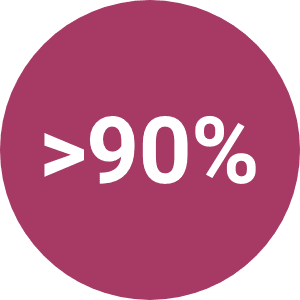Trial Design
Images are not of actual patients
ULTOMIRIS® was studied in one of the longest randomized clinical trials of an adult anti-AChR antibody-positive gMG treatment, in a broad population of patients1,2
CHAMPION-MG was a randomized, double-blind, placebo-controlled trial with an open-label extension
(OLE)1-3
Patients were randomized to receive either ULTOMIRIS (ravulizumab-cwvz) (n=86) or placebo (n=89) for 26 weeks and were subsequently allowed to enter the OLE period for up to 4 years.1-3
meningococcal vaccination1,2 N=175
1:1
randomization1,2
1 weight-based infusion every 8 weeks, 2 weeks
following initial weight-based loading dose3 Placebo (n=89)1,2
randomization
2-4 weeks
treatment (double-blind)
26 weeks
extension
OLE (up to 4 years),
ULTOMIRIS (n=78)1
Placebo (n=83)1
Key inclusion and exclusion criteria
Key inclusion criteria2
Patients enrolled in this trial had to have:
- An MGFA clinical classification of class II through IV
- Generalized myasthenia gravis (gMG) (diagnosed for at least 6 months) with a positive serologic test for anti-AChR antibodies
- MG-ADL total score ≥6
- Vaccinations against meningococcal infections
Patients on concomitant ISTs were required to be on stable doses throughout the primary treatment period.
Key exclusion criteria2
Patients were excluded from this trial if they had:
- Any active or untreated thymoma or history of thymic carcinoma or thymic malignancy
- History of thymectomy, thymomectomy, or any thymic surgery within 12 months prior to screening
- Clinical features consistent with myasthenic crisis/exacerbation or clinical deterioration at the time of the screening visit or at any time prior to randomization
- Therapies that were used within the following timeframes:
- IVIg or PE within 4 weeks prior to randomization (Day 1)
- Rituximab within 6 months prior to screening
- Any previous treatment with complement inhibitors
CHAMPION-MG baseline characteristics2,3


More than 90% of patients had MGFA class II or III generalized myasthenia gravis with mild or moderate weakness at baseline.2
The majority of symptomatic patients were already being treated with an IST2
In the randomized, double-blind, placebo-controlled CHAMPION-MG trial, approximately 90% of patients were taking an IST at baseline across both treatment arms.2,3
- 47% of patients were taking 2 or more ISTs2
43% of patients received IVIg in the 2 years prior to trial screening.4
Over 80% of patients were receiving acetylcholinesterase inhibitors, 70% were receiving corticosteroids, and 68% were receiving non-steroidal ISTs at study entry.3
- Patients on concomitant medications to treat gMG were required to continue on therapy at stable doses throughout the course of the study, and those medications could be adjusted as necessary during the OLE at the investigator's discretion1
Multiple endpoints were studied in the gMG trial, CHAMPION-MG3
Primary endpoint3:
- Change from baseline to Week 26 in the MG-ADL total scorea
Secondary endpointsb,c:
- Change from baseline to Week 26 in the QMG total score3,d
- The proportion of patients with improvements of at least 5 points in their QMG total score3
- Change in revised Myasthenia Gravis Quality of Life 15-item scale (MG-QoL15r)2
- Change in Neurological Quality of Life (Neuro-QoL) Fatigue assessment2
- The proportion of patients with improvements of at least 3 points in their MG-ADL total score3